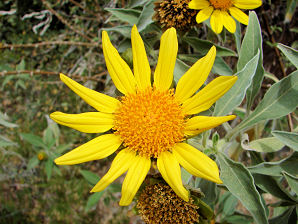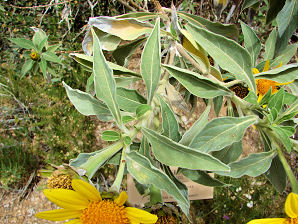Xeriscape Landscaping Plants For The Arizona Desert Environment.
Pictures, Photos, Information, Descriptions,
Images, & Reviews.
Annuals.
Mexican Sunflower, Tithonia fruticosa.
We Are Proud Of Our SafeSurf Rating!
Click On Any Of The Following Links By Amazon.Com
For Books, & Videos About Wildflowers Of Arizona & The Southwest USA. No Obligation!
 |
| Mexican Sunflower, Tithonia fruticosa. Flowering Photos Taken April 19, 2008. Arizona-Sonora Desert Museum. Near Tucson, Arizona. |
|---|
 |  |
| Mexican Sunflower. Tithonia fruticosa. | Mexican Sunflower. Tithonia fruticosa. |
|---|
Mexican Sunflower.
We wish to thank Wikipedia, the free encyclopedia for some of the information on this page. We share images and information with Wikipedia. Tithonia fruticosa is a fast growing, stout, dense shrub of mostly upright stems, sometimes growing very large in cultivation. It has olive - green leaves and stems that are are velvety. Its' leaves are wide at the base, then narrowing to a pointed tip, about 2� to 12 inches long. Tithonia fruticosa has bright yellow flower heads which are from about 2� to 3� inches wide. When its flowers dry up, the petals fall off and a golden brown, rounded seed-head remains. It contains many narrow black seeds. Butterflies visit the flowers for nectar and the seeds are relished by birds. Tithonia fruticosa is uncommon in most nurseries. The smaller Mexican Sunflower (T. rotundifolia) can be purchased from several nurseries.
Quick Notes:
Height: Up To 4 to 6 feet tall. 3 to 4 feet wide.
Flowers: Brilliant orange-yellow, up to about 2� to 3� inches in diameter; almost constantly in bloom.
Flowering Time: Begins in Arizona during the summer monsoon season (July - mid September), again in the fall (October - November).
Leaves: Coarse, 3 - lobed, 4 - 10 in long and 2 - 4 in wide. Covered with a soft fur.
Found: Native of southern Arizona & northern Mexico: Sonora, Chihuahua, Durango, Zacatecas, Sinaloa. There are about 10 species of Tithonia native to Mexico in Sonora and Sinaloa to Chihuahua and Durango, and into Central America.
Hardiness: Said to grow in Brookville, Kansas (Zone 5b). Grown as an annual in Nichols, Iowa (Zone 5a).
Soil pH requirements:
Sun Exposure:
Elevation: 0 - 4,800 feet.
Habitat: Well drained sandy desert soils, slopes, mesas, and disturbed rocky soil.
Miscellaneous: Flowering Photos Taken April 19, 2008. Arizona-Sonora Desert Museum. Great Xeriscape plant. Can be a perennial.
|
We Are Proud Of Our SafeSurf Rating!
Click On Any Of The Following Links By Amazon.Com
For Books, & Videos About Wildflowers Of Arizona & The Southwest USA. No Obligation!
| © 1966 - Present, Audrey, Eve, & George DeLange |
